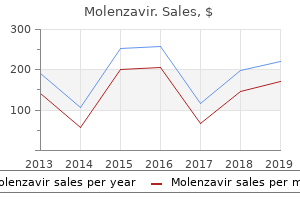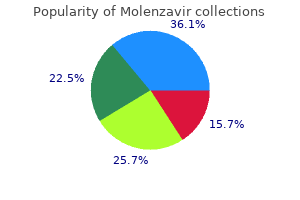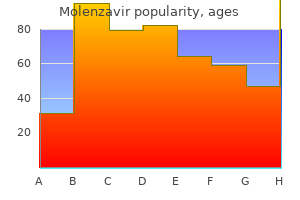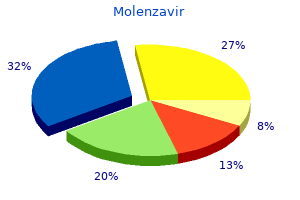"Buy generic molenzavir 200 mg line, hiv infection icd 10".
By: H. Trano, M.B. B.CH. B.A.O., Ph.D.
Clinical Director, University of South Carolina School of Medicine
To avoid dislodging the temporary restorations with the aligners fiebig stages hiv infection molenzavir 200 mg low cost, be sure to use a durable cement hiv infection rate pakistan discount molenzavir 200 mg free shipping. Posterior extrusion with aligners alone should be avoided, as this is a less predictable movement. If the uneven gingival margin is in an esthetic zone, some gingival re-contouring may be required after completion of the orthodontic movements. Attachments were placed on the upper canines to help anchor the aligners for the intrusion movements. The canines were rotated without attachments, though they are typically recommended. The advancement will also help to relieve crowding by increasing the available space. Sagittal relation, increased overjet, upright placement of upper & lower incisors. Deep overbite, deep Curve of Spee Decrease overbite by intrusion of upper and lower incisors. These movements will correct the Curve of Spee, and will improve the reverse smile line evident especially on the left lateral view. The decreased overbite will create the clearance needed for lower incisor advancement. Good leveling of the upper and lower Curve of Spee, resulting in reduction of the overbite. Lingually displaced teeth commonly overerupt until they encounter an incisal stop. To enable correction of the lower crowding, the increased overbite must also be addressed. Transverse dental midline is off to the left slightly, due to asymmetric lower crowding. Moderate crowding in the lower Resolve upper crowding via buccal uprighting of the posterior teeth, flaring of the lateral incisors, and retraction of upper centrals. Resolve lower crowding via anterior proclination, buccal uprighting of the posterior teeth, and interproximal reduction. Arch Length arch, #24 blocked out to the lingual, mild crowding in the upper arch, anterior rotations. Open Bite addressed here are the relationships between different conditions that exist in the majority of patients. Treatment options by suggested Invisalign experience level Initiator (015 cases) Experienced (1650 cases) Open Bite Advanced (more than 50 cases) Dental Skeletal Incisors Flared Incisors Upright 6. The most predictable way to correct open bite with Invisalign is by tipping back the incisors, thereby creating a relative extrusion effect to deepen the bite. In some cases, open bite can be caused by poor buccal-lingual coordination of the posterior segment and improving the coordination can reduce the vertical dimension of the patient. This may require orthognathic surgery to address the skeletal component, with Invisalign being used as the treatment of choice to address the dental component. Bonding buttons to teeth and extruding them with vertical elastics is a typical way to achieve absolute extrusion either prior to or during Invisalign treatment. Be sure to allow adequate time for bone to develop around the teeth to avoid relapse. When treating a patient with skeletal open bite, the surgical plan has to be coordinated with an oral surgeon and a final discussion held with the patient to agree on the treatment goal. Once the goal is determined then the patient may start to wear pre-surgical aligners to align the teeth. After surgery, the patient can benefit from a brief phase of treatment to complete any remaining alignment needed. A treatment goal that aligns the teeth but maintains the open bite can be considered if skeletal open bite correction is not an option. Staging the less predictable movement (absolute extrusion) after the predictable movement (retroclination) reduces the risk of failure. Open bite stability requires diligent retainer wear, in this case a lower bonded 33 and upper Hawley.

This makes sense hiv transmission statistics united states molenzavir 200mg discount, as any acute infection (bacterial or viral) will increase insulin resistance and worsen glycemic control hiv infection means molenzavir 200mg fast delivery, even in non-diabetic patients (Yri-Jarvinen et al 1989, Grossi et al 2004, Zadik 2010). This means that periodontal disease lends to not only poor diabetic control, but maybe more importantly to the increased severity of diabetic complications (wound healing, microvascular disease) as well as cardiac and renal disease (Iacopino et al 2001, Taylor et al 1996, Thorstensson et al 1996, Tsai et al 2002, Southerland et al 2006, Saremi et al 2005, Thorstensson et al 1996). Malignancies: While far from definitive due to the large number of confounding factors (Meyer et al 2008), recent studies are proposing a link between periodontal disease and distant neoplasia such as gastrointestinal, kidney, pancreatic, and hematological cancers. Chronic inflammation: It has been proven that periodontal disease can elicit an increase in inflammatory lipids as well as an overall lipidemic state (Nibali et al 2007, Lah et al 2003, Renvert et al 1996, Scannapieco 2004, Rawlinson et al 2005, Winning et al 2015, (Moutsopoulos and Madianos 2006, Iacopino and Cutler 2004, Ebersole et al 1999, Salvi et al 1998). Early mortality: A strikingly significant indicator of the degree to which periodontal disease affects overall health is demonstrated in mortality studies. When all other risk factors are ruled out, periodontal disease has been shown to be a significant predictor of early mortality in human beings (Jansson et al 2002, Avlund et al 2009, Holm-Pedersen et al 2008). In fact, one study reported that severe periodontal disease is a higher risk factor than smoking (Garcia et al 1998). Systemic benefits of periodontal therapy: While these numerous studies do not prove a cause and effect relationship, the sheer numbers are highly suggestive of a link. However, further support for the role that periodontal disease plays in systemic disease is provided by studies that show improvement in health markers following periodontal therapy. Periodontal therapy can decrease the level of circulating inflammatory products and improve endothelial function (Correa et al 2010, Duarte et al 2010, Mercanoglu et al 2004, Hayashi et al 2017). There is also evidence to suggest that periodontal therapy improves renal function (Artese et al 2010, Grazini et al 2010, Hayashi et al 2017). Periodontal therapy has been shown to improve liver values and increase lifespan in patients with cirrhosis (Hayashi et al 2017, Tomofuji et al 2009, Lins et al 2011, Grшnkjжr 2015). Conclusion: While the aforementioned studies are not definitive, periodontal disease is an infectious process that requires affected patients to deal with dangerous bacteria on a daily basis, leading to a state of chronic disease (Harvey and Emily 1993, Holmstrolm et al 1998). Therefore, we must learn to view periodontal disease as not merely a dental problem that causes bad breath and tooth loss, but as an initiator of more severe systemic consequences. As one human text states, "Periodontitis is a gram-negative infection resulting in severe inflammation, with potential intravascular dissemination of microorganisms throughout the body" (Mealey and Klokkevold 2006). This is echoed by additional authors who state: "Periodontal disease is clearly an important and potentially life threatening condition, often underestimated by health professionals and the general public". Key Points: Periodontal disease is by far the most common medical condition in small animal veterinary patients. Plaque forms within 24 hours, calculus within 3 days and gingivitis begins as early as 2 weeks. Periodontal inflammation is caused by subgingival plaque; therefore, control of plaque needs to address both supra- and more importantly subgingival plaque to be effective at controlling disease. National Companion Animal Study (1996) University of Minnesota Center for companion animal health. El al (1995): Occurrence of gram-negative black-pigmented anaerobes in subgingival plaque during the development of canine periodontal disease. Westfelt E, Rylander H, Dahlen G, Lindhe J (1998) the effect of supragingival plaque control on the progression of advanced periodontal disease. Rosenquist K (2005) Risk factors in oral and oropharyngeal squamous cell carcinoma: a population-based case-control study in southern Sweden. Talamini R, Vaccarella S, Barbone F, Tavani A, La Vecchia C, Herrero R, Muсoz N, Franceschi S (2000) Oral hygiene, dentition, sexual habits and risk of oral cancerBr J Cancer, 83 (9). Pavlica Z, Petelin M, Juntes P, et al (2008) Periodontal disease burden and pathological changes in the organs of dogs. Renvert S, Wirkstrom M, et al (1996) Histological and microbiological aspects of ligature induced periodontitis in beagle dogs. Ohyama H, Nakasho K, Yamanegi K, Noiri Y, Kuhara A, Kato-Kogoe N, et al (2009) An unusual autopsy case of pyogenic liver abscess caused by periodontal bacteria. Baylis C (1987) Effects of administered thromboxane on the intact, normal rat kidney. Franek E, Blach A, et al (2005) Association between chronic periodontal disease and left ventricular hypertrophy in kidney transplant recipients. Mercanoglu F, Oflaz H, Oz O, et al (2004) Endothelial dysfunction in patients with chronic periodontitis and its improvement after initial periodontal therapy. Garcia R (2001) Epidemiologic Associations between Periodontal diseases and Respiratory Diseases.

The twoto three-day program will focus on career planning hiv infection rates prostitutes cheap molenzavir 200 mg with visa, financial planning and practice management hiv infection control at home molenzavir 200 mg with visa. It is safe to admit that even the fundamental core values of proper practice management are hard to teach in a series of a few one-hour lectures. It is hard to anticipate the immense depth of the "black hole" that is just around the corner. There is more to starting a practice, getting a "first job" and embarking on an associateship than there was 20 years ago. We reserve the right to edit all communications and require that all letters be signed. Letters should discuss an item published in the Journal within the past two months or matters of general interest to our readership. Gerald Niznick discusses how the latest implant design innovations are shaping the future of implantology. The last time we refinanced, it took 45 minutes of robo-signing, and I think I am now suffering from carpal-tunnel syndrome. My wife, a former banker, said it was okay because one of the documents I had signed said if the bank was not really satisfied it could change things. Now all we need is a click-of-the-mouse on the computer screen saying we agree with everything, whatever it is. Some of this is enforceable and some of it is not, but it has boosted enrollments in law schools. Authors concluded that the fluoride solution Right: A computergenerated molecular model of hydroxyapatite, the mineral component of bones and teeth. Blue atoms are calcium, red atoms are oxygen, yellow atoms are phosphorus and gray atoms are hydrogen. According to the researchers, the primary outcomes were the need for extraction or root canal therapy. However, until now, the relative merits of curing lights in current use, had not been analyzed systematically. In the comparison of bond failure risk with halogen lights and plasma arc lights, 1,851 brackets were included in both groups with no statistical difference found in bond failure risk between the groups, authors wrote. For more information, see the study in the American Journal of Orthodontics and Dentofacial Orthopedics, April 2013, 143(4 Suppl):S92-103. Sometimes things go wrong, sometimes the office fails to manage the patient with a complaint, sometimes the patient lets the world know his side of the story, sometimes the dentist tries legal intimidation and sometimes the courts find in favor of the patient. Courts have always looked beyond the signature on the dotted line and declared some agreements unenforceable. It all depends on whether both parties understood what was signed, if they had the capacity to act based on that understanding and whether reasonable people would have signed. Patients give informed consent - dentists, staff, piles of papers and computers do not. The giving of consent is an act that signals patients understand enough about what is going to happen to them that they would not change their minds if they knew any more details. A good check to see whether one has gone far enough to be understood is to ask the patient to repeat back his or her understanding of the key points. The nub: 1 "I told them so and it is in the chart," plus good luck, are all that is needed to prevail in court. Dugoni School of Dentistry, San Francisco, and editor of the Journal of the American College of Dentists. Not to mention tips to prevent patient cancellations and insight on how to evaluate your marketing efforts. And if you have an urgent question, our practice analysts are always at the ready to help. Success Rates of Restorations Placed on Endodontically Treated Teeth, Evidence Not Strong A study aiming to investigate the success rates of prosthetic restorations on endodontically treated teeth and their manner of failure has found that single crowns seem to be the best treatment modality for these teeth. The study, published in the Journal of Oral Rehabilitation, assessed the success rates for single crowns and fixed and removable dental prostheses, as well as for the different kinds of posts placed on root canal treatment teeth.


Local anesthetic techniques of the oral cavity Local anesthetic drugs produce a reversible block of sodium and potassium channels and transmission of nociceptive input hiv infection oral risk order molenzavir 200mg with visa. These blocks require minimal training and can be used for a variety of dental procedures including extractions or surgery of the oral cavity such as maxillectomy general symptoms hiv infection generic 200 mg molenzavir otc, mandibulectomy, among others. Some considerations are presented below: Unfortunately, local anesthetic techniques are not widely employed in veterinary medicine due to the lack of familiarity with use. These drugs are readily available and should be incorporated in the anesthetic management of patients with oral and maxillofacial disorders. It is important to note that techniques used in dogs cannot be directly extrapolated to cats due to anatomical differences between species. These techniques can be watched on the YouTube channel of the Faculty of Veterinary Medicine, Universitй de Montrйal (links are provided below). Materials: Loco-regional anesthetic techniques of the oral cavity require simple and low-cost materials such as disposable 1 mL syringes, 25-mm to 30-mm 27-G or 25-G needles. Larger needles should be avoided as they may cause nerve and vascular damage while smaller needles may produce excessive pressure at injection and result in local tissue damage. Drugs Table 4 shows common doses and concentrations of local anesthetics (Table 4). Levobupivacaine or bupivacaine may be preferred over lidocaine for local anesthetic techniques of the oral cavity due to its prolonged duration of action. However self-mutilation has been anecdotally reported if the oral cavity and particularly the tongue are still anesthetized hours after the end of procedure/after extubation. Anesthesia of the lingual and mylohyoid nerves may occur during a mandibular nerve block and result in desensitization of the rostral two-thirds of the tongue. In humans the administration of buprenorphine enhances and prolongs the effects of bupivacaine after minor oral surgery (Modi M et al 2009). In dogs, bupivacaine alone or in combination with buprenorphine reduced isoflurane requirements by approximately 20%. However these drugs have different pKa, % protein binding and there is little evidence that this combination is better than bupivacaine alone. The oral cavity is widely innervated by branches of multiple cranial nerves and it is not uncommon that a block will fail (Krug W Losey J 2011). Veterinarians should use a combination of techniques which can be repeated if toxic doses (see complications below) are respected, however other analgesic techniques should always be considered. Intraosseous or intraligamentary anesthesia might be an option when other techniques have failed, however these blocks do produce intrinsic pain at injection. Avoiding complications There are some important considerations before the administration of any local anesthetic block to avoid complications Calculation of toxic doses - Local anesthetic toxicity may occur when dosage regimens and intervals of administration are not properly calculated. In dogs and cats, it is well accepted that doses higher than 10 mg/kg (dogs) and 5 mg/kg (cats) of lidocaine, and 2 mg/kg of bupivacaine (both species) might induce clinical signs of toxicity such as seizures, cardiorespiratory depression, coma and death. Negative aspiration of blood - Veterinarians should always check for negative aspiration of blood to avoid accidental intravenous administration before drug administration especially when administering bupivacaine due to its cardiotoxic profile (Aprea F et al 2011). If bupivacaine is administered intravenously, dysrhythmias such as ventricular premature contractions may be observed. Intravenous administration is a not an issue with lidocaine, however block may not be effective and hematoma/bleeding may occur. Resistance to injection A local block should not be performed if resistance to injection is encountered since this could indicate nerve needle penetration and risk of nerve damage. Complications after local anesthetic blocks of the oral cavity are rare but have been reported and include globe penetration most often requiring enucleation (Perry R et al 2015). Veterinarians should not be afraid to use these techniques; however these techniques should be used with cautious using appropriate landmarks. Local blocks should be avoided in the presence of abscesses or neoplasia due to the risk of dissemination of infection or neoplastic cells, respectively. Inflammation and failure of local anesthetic block Local anesthetics have a pKa between 7. This formulation gives a net prevalence of the ionized form and is thus water soluble.

Osteoarthritis also has a strong positive relationship with body mass (Coggon et al hiv infection rate minnesota generic molenzavir 200mg line. Bending occurs mostly at the midshaft stages of hiv infection to aids buy molenzavir 200mg lowest price, whereas the epiphyses near the joint are mostly loaded in compression. The torsional forces are distributed over the entire surface of a bone (Frankel and Nordin, 1980). Increasing surface area or cross-sectional area, increases bone strength to both compression and tension. A simple demonstration of bending strength 4 this document is a research report submitted to the U. The analogy of the ruler is useful for considering the diaphysis of the load bearing long bones of the lower limb. A shape index or Imax/Imin ratio, which equals the moments of inertia in the direction of greatest bending divided by the moments of inertia in the direction of least bending strength is suggested to account for activity levels (Ruff, 1987). A higher ratio, or more antero-posterior (a-p) elongated shaft, would have greater a-p strength in bending at the midshaft. This orientation of the diaphysis has been shown to be the result of greater flexion at the knee. Recognizing the biomechanics of obesity provides a step closer to understanding how to recognize skeletal covariates of obesity. As the percentage of obese individuals increases rapidly in the living populations, so will the percentage representation in forensic cases. When considering that the major joints of the legs are exposed to loads that are 1. As stated previously, a-p bending forces are greatest in extreme flexion of the knee, but you do not see this in obese individuals. The load-bearing elements of the lower limbs of obese individual will be affected primarily by greater axial loading. The greater axial loading in the obese individual will result in a very thick, but nonetheless 5 this document is a research report submitted to the U. Asymmetry in knee malalignment is common as a compensatory mechanism in obese individuals which leads to knee instability and osteoarthritis (Sharma et al. Previous studies support my hypothesis that body mass will correlate best with femoral cross-sectional area, both of which used radiographic scans of living subjects. In one study by Ruff, Scott, and Liu (1991), cross-sectional dimensions of the shaft correlated well with current weight, except for one outlier. The cross-sectional area for her femoral diaphysis correlated extremely well with her body mass. This case indicates a potentially significant reversal in bone remodeling for an adult with endosteal deposition rather than resorption. Two studies found cross-sectional femoral measures correlate strongly with body mass during growth (Eckstein et al. Ruff, Scott and Liu (1991) and Ruff (2000) found correlations with body mass and cross 6 this document is a research report submitted to the U. In the latter study, reflecting the current body weight more than the body weight at age 18. Previous research on cross-sectional geometry, bone density, and degenerative joint disease indicates that obesity will result in a suite of traits. The combination of decreased knee flexion and increased axial compression in ambulatory obese individuals will lead to in an increase in cross-sectional area, without an increase in area moments of inertia or torsional strength. Thus, obese individuals would have thick cortical area with a relatively round (a-p = m-l) and narrow shaft diameter for their body mass estimate, if not flattened mediolaterally (m-l > a-p). The load bearing elements of the lower limbs of obese individual will be subjected to greater compressive loads. At the other end of the load-bearing spectrum, emaciated individuals will be more likely represented by individuals suffering from low bone density (osteopenia), increased fracture risk (osteoporosis) and reduced cortical area. Many factors influence bone density including diet, exercise, body mass, peak bone mass, sex, age and ancestry.
Purchase molenzavir 200 mg. Living with HIV.

